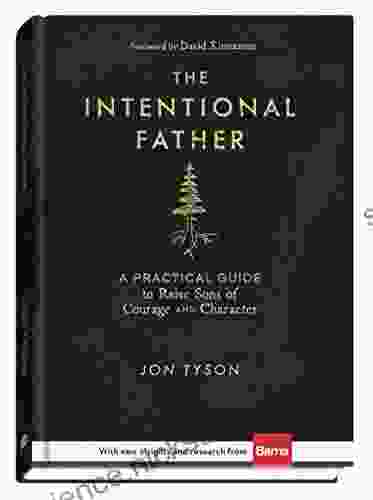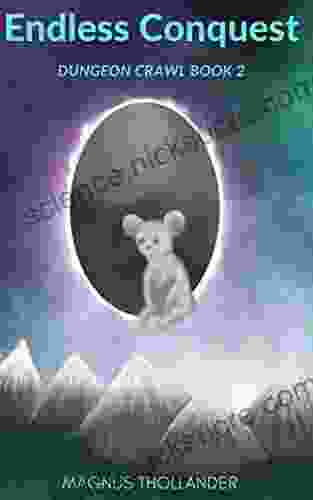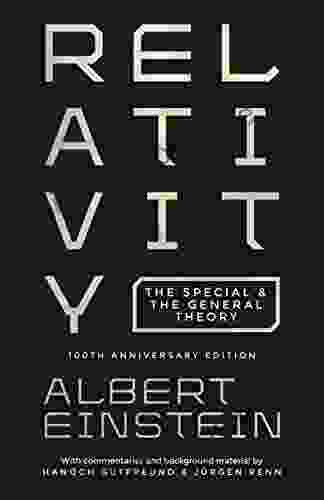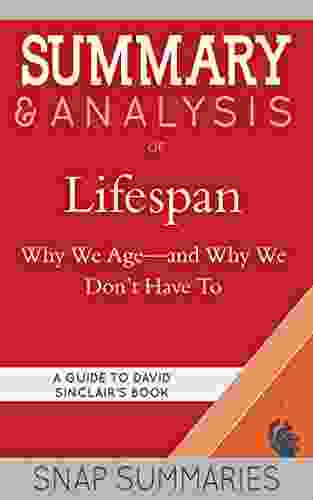Why We Age and Why We Don't Have To: A Guide to David Sinclair's Anti-Aging Research

Aging is a complex biological process that has puzzled scientists and philosophers for centuries. As we grow older, our bodies undergo a series of changes that can lead to a decline in health and function. These changes are often attributed to the accumulation of damage to our cells and tissues over time, but recent scientific research has challenged this traditional view of aging.
One of the leading researchers in the field of anti-aging is David Sinclair, a professor of genetics at Harvard Medical School. Sinclair's research has focused on identifying the underlying mechanisms that control aging and developing therapies that can target these mechanisms to extend human lifespan and healthspan.
In this article, we will explore Sinclair's groundbreaking discoveries, which have provided new insights into the biology of aging and offer promising hope for the future of human longevity.
4.4 out of 5
| Language | : | English |
| File size | : | 1421 KB |
| Text-to-Speech | : | Enabled |
| Screen Reader | : | Supported |
| Enhanced typesetting | : | Enabled |
| X-Ray | : | Enabled |
| Print length | : | 41 pages |
| Lending | : | Enabled |
The traditional view of aging is that it is a gradual, irreversible process that is caused by the accumulation of damage to our cells and tissues. This damage is thought to occur as a result of a number of factors, including:
- Oxidative stress: This is the damage caused by free radicals, which are unstable molecules that can damage cells and DNA.
- Inflammation: This is a response to injury or infection that can damage cells and tissues.
- Glycation: This is the process by which sugar molecules attach to proteins and fats, which can lead to the formation of harmful compounds called advanced glycation end products (AGEs).
As we age, the accumulation of this damage can lead to a decline in the function of our cells and tissues, which can eventually lead to the development of age-related diseases such as cancer, heart disease, and Alzheimer's disease.
Sinclair's research has challenged the traditional view of aging by demonstrating that it is not an inevitable process. He has identified a number of genes and proteins that play a role in controlling aging, and he has developed therapies that can target these genes and proteins to extend lifespan and healthspan.
One of the most important discoveries made by Sinclair is the role of NAD+ in aging. NAD+ is a molecule that is found in all cells of the body, and it is essential for a variety of cellular processes, including energy production, DNA repair, and gene expression. Sinclair has shown that NAD+ levels decline with age, and that this decline is a major contributing factor to the aging process.
Sinclair has also identified a number of other genes and proteins that play a role in aging, including sirtuins, forkhead box O (FOXO) proteins, and mTOR. Sirtuins are a family of proteins that are involved in a variety of cellular processes, including DNA repair, metabolism, and stress resistance. FOXO proteins are a family of transcription factors that are involved in cell growth, metabolism, and apoptosis. mTOR is a protein that is involved in cell growth, metabolism, and aging.
Sinclair has developed a number of therapies that target these genes and proteins to extend lifespan and healthspan in animal models. These therapies include:
- NAD+ precursors: These are compounds that can be converted into NAD+ in the body. Sinclair has shown that NAD+ precursors can extend lifespan and healthspan in animal models.
- Sirtuin activators: These are compounds that activate sirtuins. Sinclair has shown that sirtuin activators can extend lifespan and healthspan in animal models.
- FOXO activators: These are compounds that activate FOXO proteins. Sinclair has shown that FOXO activators can extend lifespan and healthspan in animal models.
- mTOR inhibitors: These are compounds that inhibit mTOR. Sinclair has shown that mTOR inhibitors can extend lifespan and healthspan in animal models.
Sinclair's research has now progressed to clinical trials in humans. These trials are investigating the safety and efficacy of NAD+ precursors, sirtuin activators, FOXO activators, and mTOR inhibitors in humans.
The results of these clinical trials are still pending, but early results are promising. For example, a study published in the journal Nature Medicine in 2019 showed that a NAD+ precursor called NR increased NAD+ levels in humans and improved mitochondrial function.
Sinclair's research is providing new hope for the future of human longevity. His groundbreaking discoveries have challenged the traditional view of aging and offer promising insights into the potential for extending human lifespan and healthspan.
The clinical trials that are currently underway will provide important data on the safety and efficacy of Sinclair's therapies in humans. If these trials are successful, it is possible that we will soon have new treatments that can help us to live longer, healthier lives.
The science of aging is a rapidly evolving field, and David Sinclair is at the forefront of this research. His groundbreaking discoveries are providing new insights into the biology of aging and offer promising hope for the future of human longevity.
As our understanding of aging continues to grow, we are likely to see new treatments that can help us to live longer, healthier lives. Sinclair's research is playing a major role in this effort, and he is paving the way for a future in which aging is no longer a barrier to human potential.
4.4 out of 5
| Language | : | English |
| File size | : | 1421 KB |
| Text-to-Speech | : | Enabled |
| Screen Reader | : | Supported |
| Enhanced typesetting | : | Enabled |
| X-Ray | : | Enabled |
| Print length | : | 41 pages |
| Lending | : | Enabled |
Do you want to contribute by writing guest posts on this blog?
Please contact us and send us a resume of previous articles that you have written.
 Fiction
Fiction Non Fiction
Non Fiction Romance
Romance Mystery
Mystery Thriller
Thriller SciFi
SciFi Fantasy
Fantasy Horror
Horror Biography
Biography Selfhelp
Selfhelp Business
Business History
History Classics
Classics Poetry
Poetry Childrens
Childrens Young Adult
Young Adult Educational
Educational Cooking
Cooking Travel
Travel Lifestyle
Lifestyle Spirituality
Spirituality Health
Health Fitness
Fitness Technology
Technology Science
Science Arts
Arts Crafts
Crafts DIY
DIY Gardening
Gardening Petcare
Petcare Jill Homer
Jill Homer Charlotte Markey
Charlotte Markey Will Storr
Will Storr Tod E Bolsinger
Tod E Bolsinger David Roberts
David Roberts Linda G Morris
Linda G Morris Ai Publishing
Ai Publishing Al Marlowe
Al Marlowe Noha Mellor
Noha Mellor Stephen Wolfram
Stephen Wolfram Steven H Strogatz
Steven H Strogatz Princess Her
Princess Her Shing Tung Yau
Shing Tung Yau Kiku Hughes
Kiku Hughes Emeran Mayer
Emeran Mayer Rebecca Jones
Rebecca Jones Lecile Harris
Lecile Harris Jacqueline Tourville
Jacqueline Tourville Suze Guillaume
Suze Guillaume Alan E Sparks
Alan E Sparks Andre Agassi
Andre Agassi Anne Enright
Anne Enright Bob Mayer
Bob Mayer Karen Levin Coburn
Karen Levin Coburn Alan C Acock
Alan C Acock Kim Stanley Robinson
Kim Stanley Robinson Michael Gray
Michael Gray Franz Metcalf
Franz Metcalf Ged Jenkins Omar
Ged Jenkins Omar Melissa Bashardoust
Melissa Bashardoust Jessica Cunsolo
Jessica Cunsolo Mike Rothschild
Mike Rothschild Magnus Thollander
Magnus Thollander Alan Burdick
Alan Burdick Dr Guy Leschziner
Dr Guy Leschziner Paramahansa Yogananda
Paramahansa Yogananda Bettina Gordon Wayne
Bettina Gordon Wayne Christos A Djonis
Christos A Djonis Paul G Schempp
Paul G Schempp Kareem Abdul Jabbar
Kareem Abdul Jabbar Saul Rip
Saul Rip Jane Poynter
Jane Poynter Jonathan Gottschall
Jonathan Gottschall Mista Nove
Mista Nove Sonia Nazario
Sonia Nazario Erica Westly
Erica Westly John T Hansen
John T Hansen John Bird
John Bird E Cheng
E Cheng Theodore P Jorgensen
Theodore P Jorgensen John J Miller
John J Miller Alan Lightman
Alan Lightman Alaina Talboy
Alaina Talboy Robert M Emerson
Robert M Emerson W E Fairbairn
W E Fairbairn Martin J Pring
Martin J Pring Craig Childs
Craig Childs Anthonissa Moger
Anthonissa Moger Daniel C Okpara
Daniel C Okpara Al Pasha
Al Pasha Amy Edelstein
Amy Edelstein David Jason
David Jason Amanda Ford
Amanda Ford Michael D Rich
Michael D Rich Aileen Evans
Aileen Evans Vanessa Ogle
Vanessa Ogle Margit Ystanes
Margit Ystanes Joe Clement
Joe Clement Jack Nicklaus
Jack Nicklaus Cynthia Clumeck Muchnick
Cynthia Clumeck Muchnick Letisha Galloway
Letisha Galloway Steven Horak
Steven Horak Tom Shachtman
Tom Shachtman Kerstin Gier
Kerstin Gier Betsy Tobin
Betsy Tobin Joe Berardi
Joe Berardi Gavin Francis
Gavin Francis Melinda Rushe
Melinda Rushe Kevin B Shearer
Kevin B Shearer James Willard Schultz
James Willard Schultz Gary Smith
Gary Smith Jeanne Faulkner
Jeanne Faulkner Laurie Pickard
Laurie Pickard Jessica Cornwell
Jessica Cornwell Jon Tyson
Jon Tyson Dmitry Zinoviev
Dmitry Zinoviev Juliet Marillier
Juliet Marillier John Muir
John Muir Shoshana Levin Fox
Shoshana Levin Fox Alan Gelb
Alan Gelb Andy Zipser
Andy Zipser Bradley Efron
Bradley Efron Hervey Garrett Smith
Hervey Garrett Smith Gail Tully
Gail Tully Gregory J Davenport
Gregory J Davenport Michael Miller
Michael Miller Albert Einstein
Albert Einstein Mariam N Ottimofiore
Mariam N Ottimofiore Madeline Milne
Madeline Milne Al Roker
Al Roker Amye Archer
Amye Archer George E Andrews
George E Andrews Angelina Wilson
Angelina Wilson Gill Rapley
Gill Rapley Anahad O Connor
Anahad O Connor Percy Boomer
Percy Boomer G H Hardy
G H Hardy Len Sperry
Len Sperry Helen Palmer
Helen Palmer Takuan Soho
Takuan Soho Daphne Rose Kingma
Daphne Rose Kingma Jay H Lefkowitch
Jay H Lefkowitch James A Michener
James A Michener Tim Gallagher
Tim Gallagher Esther Parry
Esther Parry Matthew Mcbee
Matthew Mcbee Dave Whitson
Dave Whitson Vishwesh Bhatt
Vishwesh Bhatt E A Koetting
E A Koetting Al Barkow
Al Barkow Kidada Jones
Kidada Jones Michael Sidgwick
Michael Sidgwick Robert Macfarlane
Robert Macfarlane Rose Lynn Fisher
Rose Lynn Fisher David Vine
David Vine Dimitri Loose
Dimitri Loose Molly Absolon
Molly Absolon Jane Bottomley
Jane Bottomley Barbara Scott
Barbara Scott Katharine Graves
Katharine Graves Arthur Fleischmann
Arthur Fleischmann Truman Everts
Truman Everts Stephanie Izard
Stephanie Izard Terry L Duran
Terry L Duran Dr Joseph Parent
Dr Joseph Parent Frank E Harrell Jr
Frank E Harrell Jr Bill Parisi
Bill Parisi Teresa Mccallum
Teresa Mccallum Lee Carroll
Lee Carroll Satya Sundar Sethy
Satya Sundar Sethy Alan Booth
Alan Booth John Feinstein
John Feinstein Lisa Marasco
Lisa Marasco Habeeb Quadri
Habeeb Quadri Barbara Oehlberg
Barbara Oehlberg Dr David Geier
Dr David Geier Natazha Raine O Connor
Natazha Raine O Connor Anna Hickey Moody
Anna Hickey Moody Ken Schultz
Ken Schultz G E R Lloyd
G E R Lloyd Nassim Nicholas Taleb
Nassim Nicholas Taleb Dylan Alcott
Dylan Alcott Peter Irvine
Peter Irvine Michael Casey
Michael Casey Douglas T Hall
Douglas T Hall Po Bronson
Po Bronson Aidan Comerford
Aidan Comerford Collins Easy Learning
Collins Easy Learning Constance Classen
Constance Classen Florence Williams
Florence Williams Cat Warren
Cat Warren Aimee Aristotelous
Aimee Aristotelous Michael Domican
Michael Domican Samuel Carbaugh
Samuel Carbaugh Christopher Gavigan
Christopher Gavigan Brian Mills
Brian Mills Harold Klemp
Harold Klemp Ahmed Osman
Ahmed Osman James Gleick
James Gleick Joyce Burkhalter Flueckiger
Joyce Burkhalter Flueckiger Rehana Jawadwala
Rehana Jawadwala Mark Booth
Mark Booth Robert Heidler
Robert Heidler Lexie Scott
Lexie Scott Joe Bertagna
Joe Bertagna Elaine Howard Ecklund
Elaine Howard Ecklund Helen Hollick
Helen Hollick Graham Bower
Graham Bower Linda Welters
Linda Welters Susan B Lovejoy
Susan B Lovejoy Janet Houser
Janet Houser Martin Luther King Jr
Martin Luther King Jr Lingo Mastery
Lingo Mastery Megan Gray Md
Megan Gray Md S A Klopfenstein
S A Klopfenstein Hope Smith
Hope Smith Beata Bliss Lewis Md
Beata Bliss Lewis Md Jordon Greene
Jordon Greene Martin Rooney
Martin Rooney Lisa Kenney
Lisa Kenney John Leo
John Leo Clint Emerson
Clint Emerson Cindy Hudson
Cindy Hudson Alfred S Posamentier
Alfred S Posamentier Richard Pears
Richard Pears Nick Hughes
Nick Hughes Francesca Lia Block
Francesca Lia Block Steve Moore
Steve Moore Al Yellon
Al Yellon Lauren Blackwood
Lauren Blackwood Aidan Dodson
Aidan Dodson Michael Freedland
Michael Freedland Doug Gelbert
Doug Gelbert Douglas G Altman
Douglas G Altman Gina Guddat
Gina Guddat Trevor Lund
Trevor Lund Kate Brian
Kate Brian Vera Nazarian
Vera Nazarian Arnold Yates
Arnold Yates Carol Tuttle
Carol Tuttle Spencer Wells
Spencer Wells George Knudson
George Knudson Mel Thompson
Mel Thompson Rob Casey
Rob Casey Lex Croucher
Lex Croucher Nilakantasrinivasan J Neil
Nilakantasrinivasan J Neil Howard Greene
Howard Greene Kevin Hunter
Kevin Hunter David Crabtree
David Crabtree Amelia Mayer
Amelia Mayer Alan Margot
Alan Margot Alan S Gurman
Alan S Gurman Dennis Jarecke
Dennis Jarecke John Riley
John Riley Jerry Robeson
Jerry Robeson Douglas Noll
Douglas Noll Morgan Lyle
Morgan Lyle Bob Plott
Bob Plott Alan Vermilye
Alan Vermilye Eden O Neill
Eden O Neill Larry Wasserman
Larry Wasserman Marcus Chown
Marcus Chown Belinda Luscombe
Belinda Luscombe The Rogue Hypnotist
The Rogue Hypnotist Josh Kilmer Purcell
Josh Kilmer Purcell Jay Annelli
Jay Annelli Carla Schroder
Carla Schroder Mike Warren
Mike Warren Peter Ballingall
Peter Ballingall Jamie Baulch
Jamie Baulch Conor Daly
Conor Daly Robert A Sadowski
Robert A Sadowski Gary R Varner
Gary R Varner Janice Selekman
Janice Selekman Charles J Thayer
Charles J Thayer Louis Schubert
Louis Schubert Bryan Mann
Bryan Mann M K Hume
M K Hume Sarah Hendrickx
Sarah Hendrickx Brenda Nathan
Brenda Nathan Thomas Kurz
Thomas Kurz Sheila Barton
Sheila Barton Tenth Edition Revised Kindle Edition
Tenth Edition Revised Kindle Edition Rick Bass
Rick Bass Skeleton Steve
Skeleton Steve Kevin Williams
Kevin Williams Alan Watts
Alan Watts Jerry Robertson
Jerry Robertson Tonya Johnston
Tonya Johnston Kerry Diamond
Kerry Diamond Noel St Clair
Noel St Clair Grace Lebow
Grace Lebow Orson Scott Card
Orson Scott Card Aidan Chambers
Aidan Chambers Brandy Roon
Brandy Roon Edupan7 Publishing
Edupan7 Publishing Rene D Zweig
Rene D Zweig Judy Jewell
Judy Jewell Hiro Ainana
Hiro Ainana James F Boswell
James F Boswell Harriet Brown
Harriet Brown Marsha Wenig
Marsha Wenig Snap Summaries
Snap Summaries Christopher Willard
Christopher Willard William Harding
William Harding Catherine Belknap
Catherine Belknap Kristine Barnett
Kristine Barnett Hammad Fozi
Hammad Fozi Samuel N Rosenberg
Samuel N Rosenberg Alastair Humphreys
Alastair Humphreys Judith Garrard
Judith Garrard Isabella Morris
Isabella Morris Michal Stawicki
Michal Stawicki Lisa Newton
Lisa Newton Pantea Kalhor
Pantea Kalhor Christopher Hellman
Christopher Hellman Jakob Tanner
Jakob Tanner Steve Michalik
Steve Michalik Donald Woods Winnicott
Donald Woods Winnicott Rand Cardwell
Rand Cardwell David A Sousa
David A Sousa Dean Burnett
Dean Burnett Alice Oseman
Alice Oseman Charles B White
Charles B White Thomas Metzinger
Thomas Metzinger Dorothy H Crawford
Dorothy H Crawford Alan Shipnuck
Alan Shipnuck Publishdrive Edition Kindle Edition
Publishdrive Edition Kindle Edition Alana Chernila
Alana Chernila Michael W King
Michael W King Tina Dreffin
Tina Dreffin I Johnson
I Johnson Michael Shermer
Michael Shermer Celeste Headlee
Celeste Headlee Chris Klug
Chris Klug David D Burns
David D Burns Kate Bettison
Kate Bettison Rosemarie Anderson
Rosemarie Anderson Ann Hagedorn
Ann Hagedorn Olivia Gentile
Olivia Gentile Clyde Fitch
Clyde Fitch Nick Lyons
Nick Lyons Rebekah Sack
Rebekah Sack Nicholas Romanov
Nicholas Romanov Deitra Leonard Lowdermilk
Deitra Leonard Lowdermilk Aphra Behn
Aphra Behn Micky Ward
Micky Ward Jonathan White
Jonathan White David King
David King Chris Vines
Chris Vines Al Owens
Al Owens William Foote Whyte
William Foote Whyte Don Casey
Don Casey Bobby Flay
Bobby Flay Al Macy
Al Macy Jessica Battilana
Jessica Battilana Timothy C Smith
Timothy C Smith Peg Tyre
Peg Tyre Mark Drolsbaugh
Mark Drolsbaugh Layla Moon
Layla Moon Bill Friedrich
Bill Friedrich Lj Andrews
Lj Andrews Wayne Stewart
Wayne Stewart Eddy Starr Ancinas
Eddy Starr Ancinas Julie Bradley
Julie Bradley Caitlin Zaloom
Caitlin Zaloom Hannah Ewens
Hannah Ewens Pallas Snider
Pallas Snider Nancy Hughes
Nancy Hughes Roy Dittmann
Roy Dittmann Stephen M Camarata
Stephen M Camarata James Witts
James Witts Jill Stamm
Jill Stamm Sandy Lindsey
Sandy Lindsey Michael Morpurgo
Michael Morpurgo Contractor Education Inc
Contractor Education Inc Ilan Dvir
Ilan Dvir Mike Martin
Mike Martin 12th Edition Kindle Edition
12th Edition Kindle Edition Alan E Kazdin
Alan E Kazdin Edward A Tiryakian
Edward A Tiryakian Markus Rex
Markus Rex George Buehler
George Buehler Elizabeth Thompson
Elizabeth Thompson Bianca Smith
Bianca Smith Jay Revell
Jay Revell Leigh Sales
Leigh Sales Alan Graham
Alan Graham Zondervan
Zondervan Mendocino Press
Mendocino Press Robert L Kelly
Robert L Kelly Joanne Webb
Joanne Webb Terry Funk
Terry Funk Original Edition Kindle Edition
Original Edition Kindle Edition Andrea Travillian
Andrea Travillian Roxy And Ben Dawson
Roxy And Ben Dawson Leif K Karlsen
Leif K Karlsen Robert E Stake
Robert E Stake Jacqueline Fitzpatrick
Jacqueline Fitzpatrick Shaun Tomson
Shaun Tomson Dusty Rhodes
Dusty Rhodes Vasilis Konstantinos Giontzis
Vasilis Konstantinos Giontzis Jacqueline Church Simonds
Jacqueline Church Simonds Jan Smith
Jan Smith David F Kelly
David F Kelly Meredith Marsh
Meredith Marsh Anders Halverson
Anders Halverson Sara Hanover
Sara Hanover Taquetta Baker
Taquetta Baker Jay Speight
Jay Speight Akwaeke Emezi
Akwaeke Emezi Dave Heller
Dave Heller Aitzaz Imtiaz
Aitzaz Imtiaz Sophia Joy
Sophia Joy Alan Hearnshaw
Alan Hearnshaw Juno Roche
Juno Roche Gillian Gill
Gillian Gill Mykel Hawke
Mykel Hawke Miles Mckenna
Miles Mckenna Gayle Peterson
Gayle Peterson Vernon Coleman
Vernon Coleman Penney Peirce
Penney Peirce Anne Dachel
Anne Dachel Aileen Nielsen
Aileen Nielsen Scott Surovich
Scott Surovich Akil Palanisamy
Akil Palanisamy Peter Hathaway Capstick
Peter Hathaway Capstick Martin Erwig
Martin Erwig Andy Adams
Andy Adams Jeff Maynard
Jeff Maynard Helena Clare
Helena Clare Marc M Triola
Marc M Triola William A Kaplin
William A Kaplin Gary Player
Gary Player Damon Lee
Damon Lee Alex Light
Alex Light Andrew Rowe
Andrew Rowe Howard Maxwell
Howard Maxwell Nina Lacour
Nina Lacour Kardas Publishing
Kardas Publishing Ron L Deal
Ron L Deal Christopher Scordo
Christopher Scordo Jon Emmett
Jon Emmett Andrew Blum
Andrew Blum Ainsley Arment
Ainsley Arment Kelly Jensen
Kelly Jensen Al Desetta M A
Al Desetta M A Massad Ayoob
Massad Ayoob Jacob K Olupona
Jacob K Olupona George M Fredrickson
George M Fredrickson Aiva Books
Aiva Books Jenni Hicks
Jenni Hicks Celeste Jones
Celeste Jones Gordon R Dickson
Gordon R Dickson Patrick O Sullivan
Patrick O Sullivan Emily Harris Adams
Emily Harris Adams Mark Harris
Mark Harris Margaret J Wheatley
Margaret J Wheatley Al Strachan
Al Strachan Dawn Sakamoto Paiva
Dawn Sakamoto Paiva George Monbiot
George Monbiot Al Sweigart
Al Sweigart Mackenzi Lee
Mackenzi Lee Sam J Fires
Sam J Fires Jackson Katz
Jackson Katz Aja Raden
Aja Raden Terry Breverton
Terry Breverton Bill Walker
Bill Walker R A Salvatore
R A Salvatore Erin Lovelace
Erin Lovelace Matthew Sturm
Matthew Sturm Andrew Jamieson
Andrew Jamieson Alan R Hall
Alan R Hall Pavel Tsatsouline
Pavel Tsatsouline Deborah Harkness
Deborah Harkness Alan Lawrence Sitomer
Alan Lawrence Sitomer Matt Mosher
Matt Mosher Carl Gustav Jung
Carl Gustav Jung Sir Edmund Hillary
Sir Edmund Hillary Denise Alvarado
Denise Alvarado Al Ristori
Al Ristori Ken Denmead
Ken Denmead Alan Garner
Alan Garner J R Haseloff
J R Haseloff Kai Nacke
Kai Nacke John Irving
John Irving Antipodean Writer
Antipodean Writer Mark Goulston
Mark Goulston Zita West
Zita West Mark Occhilupo
Mark Occhilupo Timm Woods
Timm Woods Jane P Gardner
Jane P Gardner Farlex International
Farlex International Sara Wickham
Sara Wickham Lo Bosworth
Lo Bosworth Alan Murchison
Alan Murchison J Zoltan
J Zoltan George Plimpton
George Plimpton Alice Scordato
Alice Scordato John H Moore
John H Moore Robin Mckinley
Robin Mckinley Alana Mclaren
Alana Mclaren Dan Dipiro
Dan Dipiro Billy Walsh
Billy Walsh Kiersten White
Kiersten White Howard Hill
Howard Hill Gary B Ferngren
Gary B Ferngren Erin Ekins
Erin Ekins Arnold Haultain
Arnold Haultain Amelia Simmons
Amelia Simmons Mary Basick
Mary Basick Donna Morang
Donna Morang Frances E Jensen
Frances E Jensen Bruce J Macfadden
Bruce J Macfadden Toby Wilkinson
Toby Wilkinson We Fairbairn
We Fairbairn Courtney Macavinta
Courtney Macavinta Bryon Powell
Bryon Powell Ndeye Labadens
Ndeye Labadens Steven Trimble
Steven Trimble Jeremy Miles
Jeremy Miles Benjamin Johnston
Benjamin Johnston Alan Porter
Alan Porter S Connolly
S Connolly United States Government Us Marine Corps
United States Government Us Marine Corps Jim Steenburgh
Jim Steenburgh Alan Rouse
Alan Rouse Yang Jwing Ming
Yang Jwing Ming Aileen Erin
Aileen Erin Chris Bowers
Chris Bowers Gordon H Orians
Gordon H Orians Alan S Kaufman
Alan S Kaufman Thubten Chodron
Thubten Chodron Bruce Lee
Bruce Lee
Light bulbAdvertise smarter! Our strategic ad space ensures maximum exposure. Reserve your spot today!

 Travis FosterDreamer Pool Blackthorn Grim: A Comprehensive Guide to the Legendary Wielder...
Travis FosterDreamer Pool Blackthorn Grim: A Comprehensive Guide to the Legendary Wielder... Dale MitchellFollow ·3.9k
Dale MitchellFollow ·3.9k Finn CoxFollow ·11.1k
Finn CoxFollow ·11.1k Jedidiah HayesFollow ·4.5k
Jedidiah HayesFollow ·4.5k Donald WardFollow ·17k
Donald WardFollow ·17k Patrick RothfussFollow ·15.9k
Patrick RothfussFollow ·15.9k Aubrey BlairFollow ·4.1k
Aubrey BlairFollow ·4.1k David MitchellFollow ·11.5k
David MitchellFollow ·11.5k Shawn ReedFollow ·2.4k
Shawn ReedFollow ·2.4k

 Deacon Bell
Deacon BellCompilation of Short Stories on Mental Illness and Ways...
Mental illness is a serious issue that affects...

 Jonathan Hayes
Jonathan HayesThe Practical Guide to Raising Courageous and...
As parents, we all want...

 Carlos Fuentes
Carlos FuentesA Journey to Remember: The High Sierra Love Story of...
Prologue: A Wilderness Encounter Beneath...

 Douglas Foster
Douglas FosterEndless Conquest: Embark on an Immersive Dungeon Crawl in...
Endless Conquest is a captivating LitRPG...

 Caleb Long
Caleb LongThe Special and the General Theory 100th Anniversary...
The year 2015 marks a...
4.4 out of 5
| Language | : | English |
| File size | : | 1421 KB |
| Text-to-Speech | : | Enabled |
| Screen Reader | : | Supported |
| Enhanced typesetting | : | Enabled |
| X-Ray | : | Enabled |
| Print length | : | 41 pages |
| Lending | : | Enabled |












